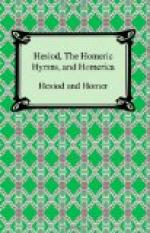(ll. 443-449) But Athene the daughter of aegis-bearing Zeus came to meet Ares, wearing the dark aegis, and she looked at him with an angry frown and spoke winged words to him. `Ares, check your fierce anger and matchless hands; for it is not ordained that you should kill Heracles, the bold-hearted son of Zeus, and strip off his rich armour. Come, then, cease fighting and do not withstand me.’
(ll. 450-466) So said she, but did not move the courageous spirit of Ares. But he uttered a great shout and waving his spears like fire, he rushed headlong at strong Heracles, longing to kill him, and hurled a brazen spear upon the great shield, for he was furiously angry because of his dead son; but bright-eyed Athene reached out from the car and turned aside the force of the spear.
Then bitter grief seized Ares and he drew his keen sword and leaped upon bold-hearted Heracles. But as he came on, the son of Amphitryon, unsated of fierce battle, shrewdly wounded his thigh where it was exposed under his richly-wrought shield, and tare deep into his flesh with the spear-thrust and cast him flat upon the ground. And Panic and Dread quickly drove his smooth-wheeled chariot and horses near him and lifted him from the wide-pathed earth into his richly-wrought car, and then straight lashed the horses and came to high Olympus.
(ll. 467-471) But the son of Alcmena and glorious Iolaus stripped the fine armour off Cycnus’ shoulders and went, and their swift horses carried them straight to the city of Trachis. And bright-eyed Athene went thence to great Olympus and her father’s house.
(ll. 472-480) As for Cycnus, Ceyx buried him and the countless people who lived near the city of the glorious king, in Anthe and the city of the Myrmidons, and famous Iolcus, and Arne, and Helice: and much people were gathered doing honour to Ceyx, the friend of the blessed gods. But Anaurus, swelled by a rain-storm, blotted out the grave and memorial of Cycnus; for so Apollo, Leto’s son, commanded him, because he used to watch for and violently despoil the rich hecatombs that any might bring to Pytho.
ENDNOTES:
(1) A mountain peak near Thebes which took its name
from the
Sphinx (called in “Theogony”
l. 326 PHIX).
(2) Cyanus was a glass-paste of deep blue colour:
the `zones’
were concentric bands
in which were the scenes described by
the poet. The
figure of Fear (l. 44) occupied the centre of
the shield, and Oceanus
(l. 314) enclosed the whole.
(3) `She who drives herds,’ i.e. `The
Victorious’, since herds
were the chief spoil
gained by the victor in ancient
warfare.
(4) The cap of darkness which made its wearer invisible.
(5) The existing text of the vineyard scene is a
compound of two
different versions,
clumsily adapted, and eked out with some
makeshift additions.
(6) The conception is similar to that of the sculptured
group at
Athens of Two Lions
devouring a Bull (Dickens, “Cat. of the
Acropolis Museaum”,
No. 3).




